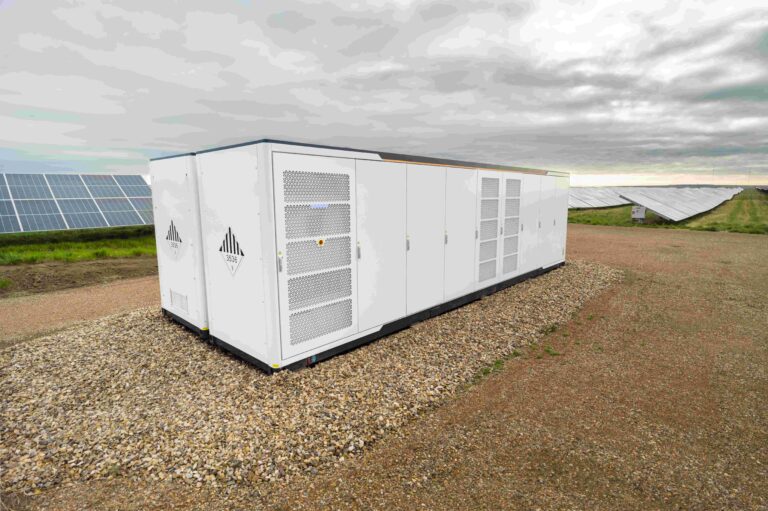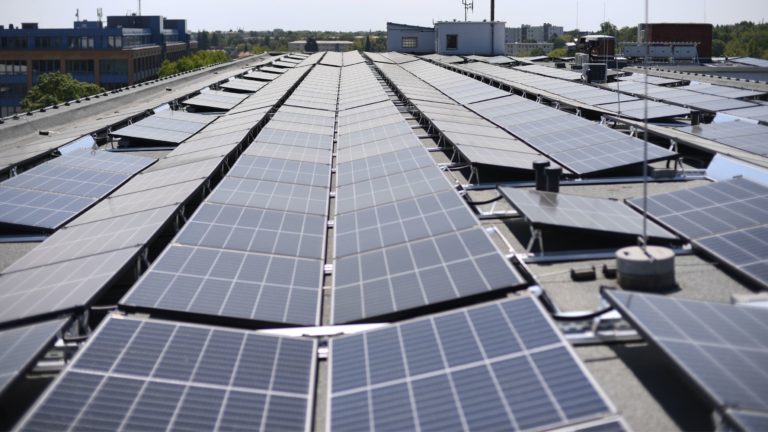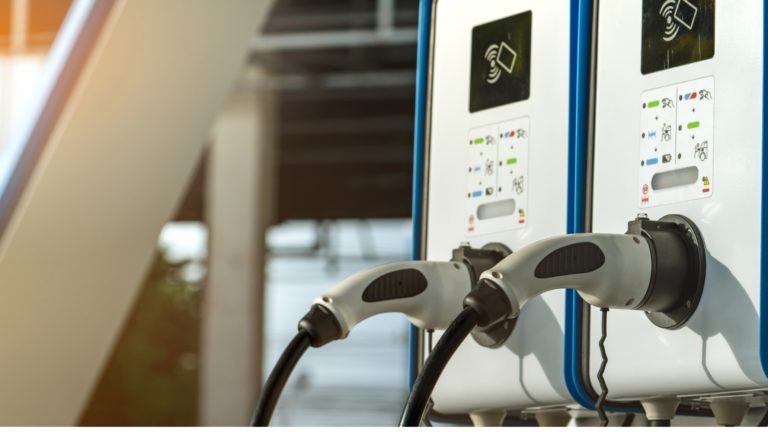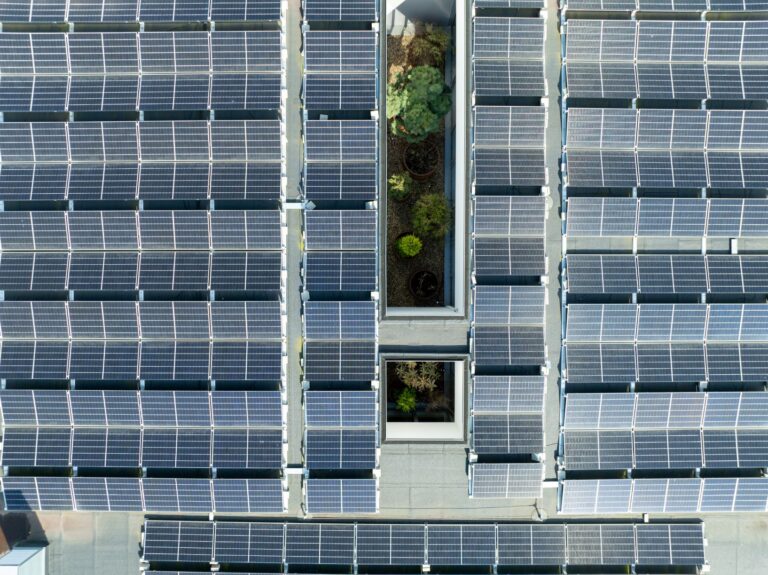To make this measure more effective and tailored to the specific context of your company, we recommend that you first perform an overall analysis of your energy situation.
Battery storage – a key lever in optimising your electricity consumption
As part of the decarbonisation process, electricity is playing an increasingly central role in businesses, gradually replacing other energy sources such as fossil fuels. It is therefore becoming increasingly more important for companies not only to control their electricity costs but also to optimise consumption and self-generation in order to maximise their energy potential – for example through the use of a photovoltaic system, and in some cases, in combination with a battery storage system.
Commercial and industrial battery storage systems, with capacities ranging from 30 kWh to several MWh, enable companies to increase the self-consumption of on-site renewable electricity generation and thus reduce energy costs. By reducing power peaks, they allow for improved peak load management and thereby significantly reduce a company’s electricity bill. To fully leverage your battery’s capacity and increase your profits it is equally essential to install an energy management system (EMS).
The following measure outlines in which scenario the installation of a battery storage system is recommended and beneficial – and how its implementation can be planned.
Defining the needs
1.1. Overview of potential applications for battery storage in commercial and industrial settings
A commercial or industrial battery storage system – especially when combined with a photovoltaic installation – can provide various operational advantages. Key application areas include:
- optimised self-consumption
- peak shaving
- emergency power supply
- shared electricity use within an energy community
- dynamic tariffs (use of variable prices on the wholesale electricity market)
Furthermore, there are additional potential monetisation mechanisms that can generate additional revenue and increase return on investment – for example, through “arbitrage on the imbalance market” or so-called “ancillary services”. However, these opportunities are currently not available in Luxembourg, as they depend on the further development of the market and the regulatory framework, which is still being established.
Optimise the use of your battery with an energy management system
EMS (Energy Management System): To activate and optimise certain applications, battery storage systems must be equipped with a compatible energy management system (EMS). This device monitors, controls, and optimises the energy flow within a circuit located behind the grid connection point. This circuit includes the battery, the inverter and its photovoltaic system, charging stations for electric vehicles, and possibly a heat pump. All of these energy devices must be capable of communicating data and receiving commands, which makes it essential to ensure their compatibility.
1.2. Analysis of typical consumption and production profiles of companies
Before investing in a battery storage system, it is important to understand the 15-minute consumption and production profiles in order to identify potential energy optimisation opportunities.
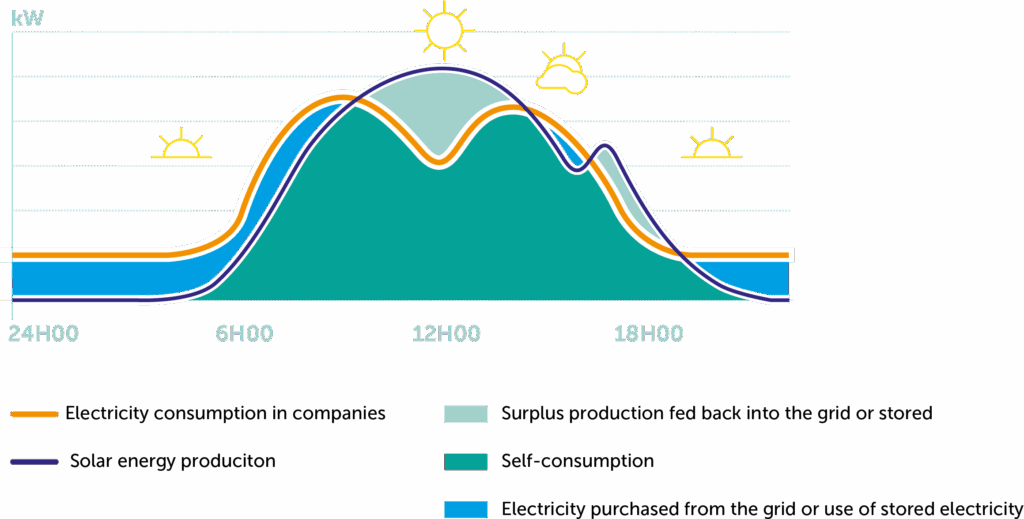
Average solar electricity production and consumption over 24 hours in a company
Identification of different energy profiles of companies
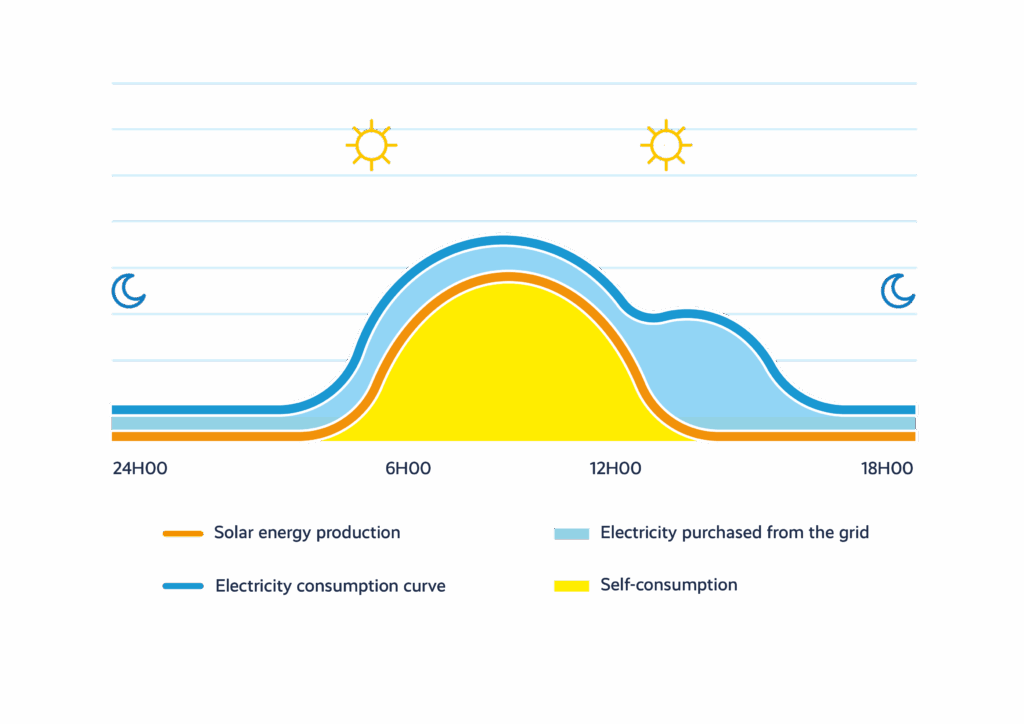
Profile A: A company with solar production below its consumption
All produced energy is self-consumed, e.g., a government office or a store with limited roof space.
➡️ Conclusion: This profile is not suitable for the installation of a battery storage system.
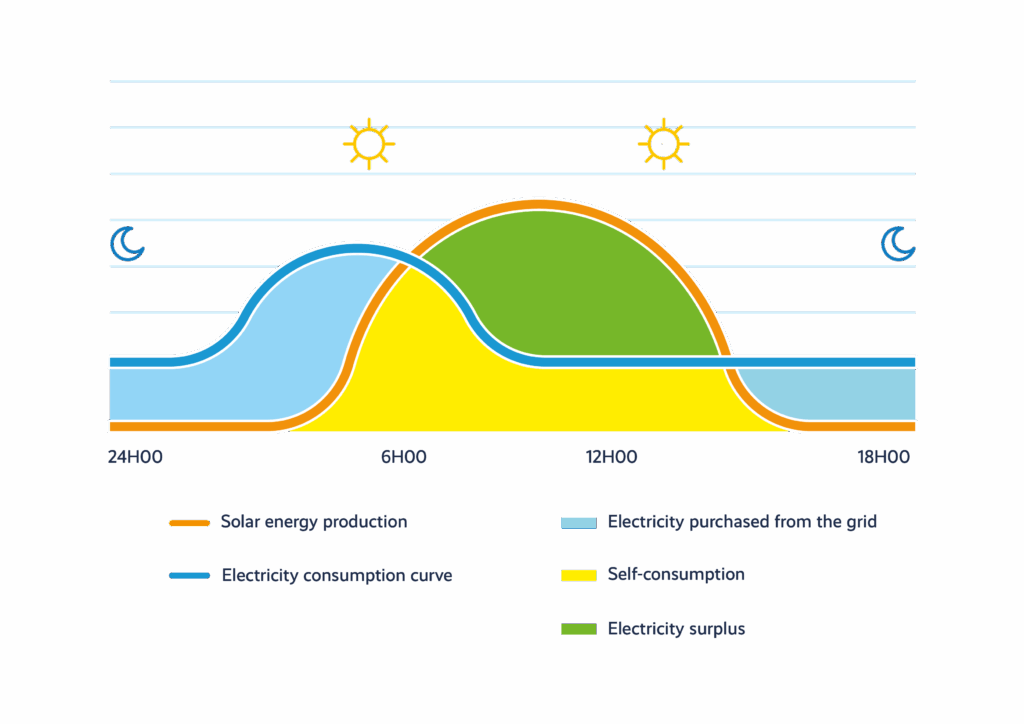
Profile B: A company that produces more during the day than it consumes
Opportunity to store excess production and release it in the evening or at night when consumption rises again, e.g., a cafeteria.
➡️ Conclusion: This profile could, under certain conditions—including a profitability calculation—consider using a battery storage system to cover the energy consumed in the morning.
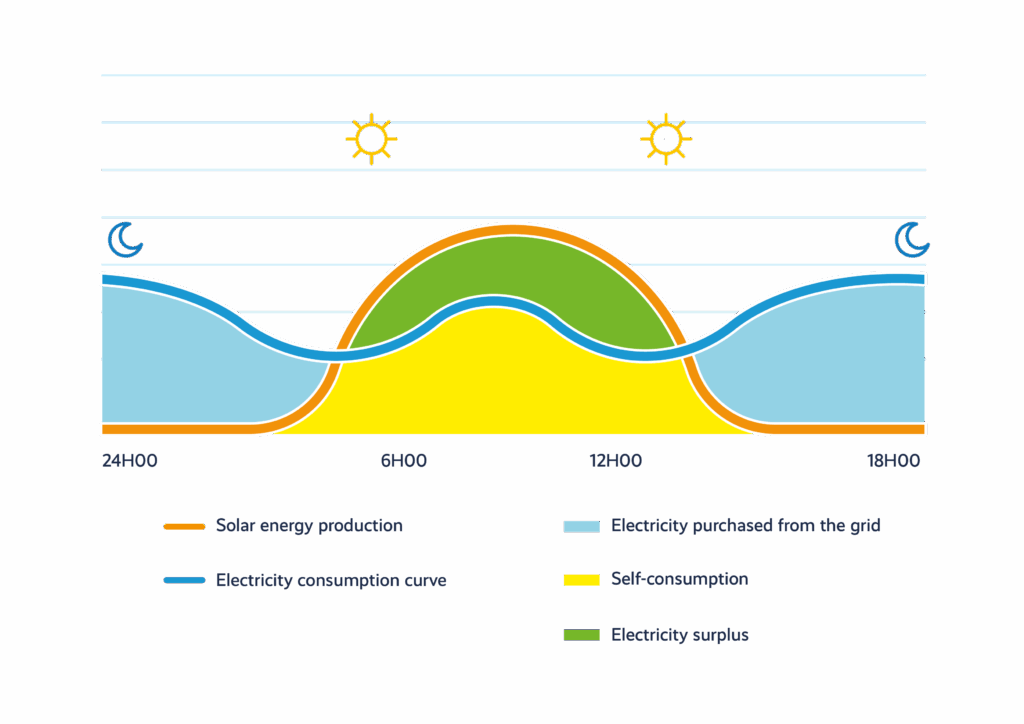
Profile C: A company that produces more energy during the day than it consumes, with a fleet of electric vehicles that are in use during the day and need to be charged at night
For example, a transport company or a postal service provider.
➡️Conclusion: This profile could, under certain conditions—including a profitability calculation—consider the use of a battery storage system to cover energy consumption during the night.
How do you obtain your consumption and production data?
- Retrieve your 15-minute interval data from Leneda, the national energy data platform.
- Ask your energy supplier.
How to interpret your data?
- Consult an engineering firm or a specialised service provider.
Inform yourself about the type of electricity contract your company has concluded:
- Low voltage or medium voltage contract?
- Fixed contract, variable contract, or dynamic tariff?
Define your future energy potential or future electricity demand:
- Possibility to expand your photovoltaic system?
- Planning future electricity consumption:
- electrification of your vehicle fleet ➡️ Installation of charging infrastructure at the company.
- replacement of the heating boiler with a heat pump.
- others.
1.3. Is investing in a battery storage system economically interesting for my company?
In which cases can investing in a battery storage system be profitable for my company
A battery is resource-intensive and remains a considerable investment, even with available subsidies. It is therefore important to consider various parameters to determine when such an installation is economically viable. Profitability increases if the following parameters are met:
- Proper sizing of the battery
- High electricity prices
- Low feed-in tariff
- Competitive battery pricef.
How to size the battery storage system?
Battery sizing is a critical factor in profitability calculations. Consult a qualified electrician or an engineering firm to professionally determine the battery size suitable for your current and future energy profile.
Making the best choice for your company’s energy consumption
A precise understanding of the consumption and production profile is crucial to correctly size the battery and, above all, to assess whether the investment is economically viable. Conscious and sensible energy consumption also enables savings through feeding excess energy back into the grid and through energy-saving behaviours. Depending on your energy profile, investing in a battery storage system is not necessarily the best solution. Discover the measure on electricity sharing.
Electricity consumption: identifying the most suitable solution and the feasibility of the battery storage installation project
Request for a feasibility study
- Compliance of the existing electrical installation
- Availability of necessary space
- Compatibility with existing photovoltaic systems (inverters)
- Compatibility with an energy management system (EMS)
Inquiry with various providers
- Grid operator for battery connection (in case of feed-in)
- Service provider/electrician who will install the battery
Calculation of investment profitability
Calculation of investment profitability
When calculating profitability, it is important to consider not only the technical feasibility of the project but also the economic feasibility, taking into account the following parameters:
- guaranteed battery lifespan (> 10 years)
- number of guaranteed charge/discharge cycles (> 5,000 cycles)
Generally, for industrial-scale battery storage, local usage alone, i.e., self-consumption and peak load shaving, yields a return on investment in the yield of about 8 to 12 years.
Identify electricity storage applications relevant to your company’s situation
A combination of different applications can significantly increase the profitability for the company. For example, by using the battery storage which is helping to increase self-consumption of solar energy in summer to engage in energy arbitrage in winter. We strongly recommend hiring an engineering firm to identify possible applications specific to your case and to assess the feasibility and profitability of the project.
Subsidy application
Government subsides
Please note: any application for government or non-government subsidies must comply with the “incentive effect”, subject to compliance with the subsidy conditions.
In order to respect the “incentive effect”, no binding commitment (signing a quotation; paying a deposit) may be made BEFORE having received the agreement in principle from the State or the electricity and natural gas supplier following an application for subsidy.
In the absence of a dedicated state subsidy for the installation of a storage battery, there are two types of subsidies available for storage batteries: those in combination with the installation of a photovoltaic system, and tax incentives.
Klimabonus: Battery (≤ 30 kWh) + PV
Investment aid of 50% for the installation of storage batteries combined with a photovoltaic installation operated in “self-consumption mode” without a guaranteed feed-in tariff. The storage system is subsidised if the building is not used for residential purposes and the storage capacity is ≤ 1 kWh/kWp. In this case, the feed-in tariff is not guaranteed, and a purchase agreement for any surplus electricity must be concluded with a provider.
- For questions: Klima-Agence
Call for tenders to support investment in large-scale photovoltaic installation projects
As part of calls for tenders for large-scale photovoltaic installation projects, the government supports the construction of photovoltaic power plants through investment aid. This subsidy is granted to encourage companies to produce their own energy.
There are currently no open calls for tenders under the investment aid scheme.
An indicative multi-year calendar now makes it possible to anticipate future opportunities.
| 2026 | ||
|---|---|---|
| Application period | Power category | Expected volume |
| 16 February – 17 April | 30 – 200 kW | 30–40 MW |
| 1 July – 30 September | All categories | |
| 2027 | ||
|---|---|---|
| Application period | Power category | Expected volume |
| 4 January – 31 March | 30 – 200 kW | 30–40 MW |
| 1 July – 30 September | All categories | |
| 2028 | ||
|---|---|---|
| Application period | Power category | Expected volume |
| 3 January – 31 March | 30 – 200 kW | 30–40 MW |
| 3 July – 29 September | All categories | |
Tax incentive for investment in an ecological and energy transition project: Battery with or without PV in self-consumption mode
The tax incentive is calculated based on investments and operating expenses incurred as part of an ecological and energy transition project. The tax credit rate is 18% for investments and operating expenses, except for depreciable tangible assets, which benefit from a rate of 6%.
Project eligibility is subject to two conditions:
- The stored energy must be produced from non-fossil renewable sources.
- The energy must be used for self-consumption.
For questions: Ministry of the Economy – Bonification
N.B. Les aides étatiques ne sont pas cumulables entre elles pour un même projet.
Request for permits for the installation of an electricity storage battery
- Request approval from the grid operator for the connection of a battery storage system.
- Request an operating permit for classified facilities subject to the nomenclature.
Execution of the Battery Storage Installation
Carry out the work in accordance with technical and regulatory requirements
- Connection regulations – TAB / Low voltage network (LV) TAB BT.
- Connection regulations – TAB / Medium voltage network (MV) TAB MT.
After the installation
- Compliance check by the grid operator (GO). The completion of the work must be reported to the grid operator by the company responsible for the installation.
- Acceptance of the installation by an authorised inspection body.
- Notification of your installation to your insurer.
Implementation aid
- Luxinnovation (accompagnement dans l'élaboration de la demande)
- Klima-Agence (accompagnement du point de vue technique)
- L’ITM vous accompagne dans votre projet d’installation de batterie de stockage. Pour toutes questions liées à votre autorisation d’exploitation (commodo), merci de bien vouloir envoyer un e-mail à l’adresse suivante : contact@itm.etat.lu
- Règlement grand-ducal modifié du 9 juin 2021 concernant la performance énergétique des bâtiments
- ILR
- Prescriptions de raccordement - TAB / Réseau basse tension (BT) : TAB BT
- Prescriptions de raccordement - TAB / Réseau moyenne tension (MT) : TAB MT.
- ITM - Loi modifiée du 10 juin 1999 relative aux établissements classés
